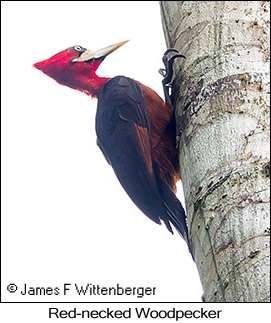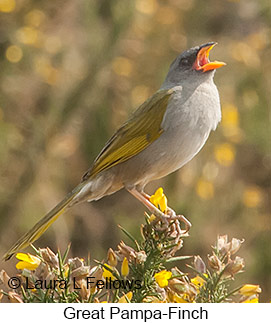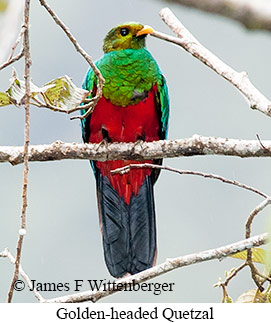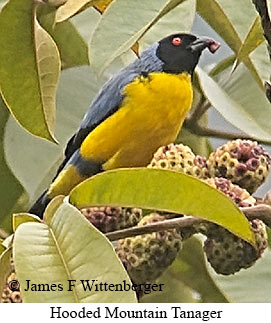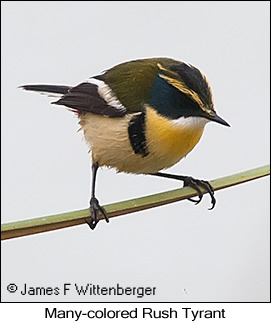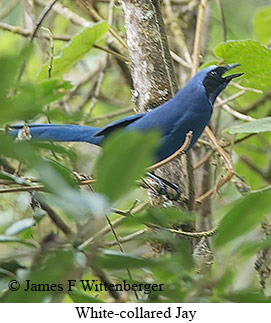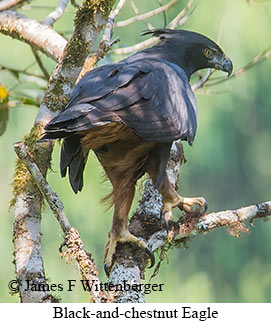BOLIVIA STANDARD TOUR
Tour Description

BOLIVIA
BIRDING TOUR
ANY TIME*
| Duration: | 16 days, 15 nights |
| Group Size: | 2-6 |
| Anytime Price: | $6750 |
| Group Price: | $6300 |
| Single Suppl: | $400 |
| Est #Species: | 450-500 |
| Pace: | Moderate |
| Difficulty: | Moderate |
| * This tour is available for any dates of your choosing provided guide services and accommodations are available. | |
DAY 1 - ARRIVE SANTA CRUZ DE LA SIERRA
Arrive Santa Cruz de La Sierra. Overnight hotel in Santa Cruz.
DAY 2 - LOMAS DE ARENA & BOTANICAL GARDENS
Early start to birding in the Santa Cruz Botanical Gardens. The two main target species are Bolivian Slaty-Antshrike and Fawn-breasted Wren. Many other forest and Chaco species are present as well including Greater Rhea, Chaco Chachalaca, Green-cheeked Parakeet, Chestnut-fronted Macaw, Black-capped Antwren, Straneck's Tyrannulet, and Orange-headed Tanager. Then visit Lomas de Arena Municipal Park on the outskirts of Santa Cruz. Park habitats include sand dunes, savanna, dry forest, marshes, and large bodies of water. Interesting species include Red-winged Tinamou, White-bellied Nothura, Comb Duck, White-tufted Grebe, Ringed Teal, White-eared Puffbird, Spot-backed Puffbird, White Woodpecker, Red-legged Seriema, Peach-fronted Parakeet, Chotoy Spinetail, and Hudson's Black-Tyrant. Overnight hotel in Santa Cruz.
DAY 3 - TRANSFER & REFUGIO LOS VOLCANES
Morning transfer to Refugio Los Volcanes, about a 2 hour drive from Santa Cruz to Bermejo. From there transfer down a steep road to the lodge area. The habitat is semi-humid foothill forest. Rest of day birding the reserve. Notable possibilities include Gray Tinamou, Brown Tinamou, White-throated Piping-Guan, a recent split from Blue-throated Piping-Guan, Razor-billed Curassow, Rufous-breasted Wood-Quail (secretive and hard to see), the spectacular Red-necked Woodpecker, Inambari Woodcreeper, Black-capped Antwren, Slaty Gnateater, Bolivian Tapaculo, Short-tailed Antthrush, Yungas Manakin, Sclater's Tyrannulet, and many tanagers. A key target species is the elusive Bolivian Recurvebill, whose presence depends on the condition of bamboo stands around the lodge. During dry season Andean Condors regularly soar overhead. Large numbers of Mitred Parakeets and Turquoise-fronted Parrots are usually present along with less common Military Macaws. Night birding may produce Rufescent Screech-Owl and Band-bellied Owl. Overnight Refugio Los Volcanes Lodge.
DAY 4 - REFUGIO LOS VOLCANES
All day birding trails through the reserve. See previous day for birding possibilities. Overnight Refugio Los Volcanes Lodge.
DAY 5 - TRANSFER TO SAMAIPATA & QUIRUSILLAS
After early breakfast transfer to Samaipata, a 2½ hour drive. Rest of day bird semi-humid cloud forest above Samaipata around Quirusillas. The main target species is the vulnerable Tucuman Parrot. A second key species is Slaty Elaenia, which has only been seen there during rainy season from December-April. Other possibilities include Red Guan, White-throated Antpitta, Dot-fronted Woodpecker, and Golden-winged Cacique. Andean Condors are sometimes seen soaring overhead. A brief stop at the waterfall outside Samaipata is worth a visit for Sharp-tailed Streamcreeper. Overnight Samaipata.
DAY 6 - QUIRUSILLAS & TRANSFER TO PERERETA
Early departure for birding Laguna Esmeralda and Quirusillas again seeking any species missed previous day. Afternoon transfer to Perereta. Overnight Armonia Lodge in Perereta.
DAY 7 - RED-FRONTED MACAW RESERVE & TRANSFER TO COMARAPA
Morning visit the top of the cliffs above Perereta looking for 3 key species, Cliff Parakeet, Red-fronted Macaw, and Bolivian Blackbird. Feeders around the lodge attract White-fronted Woodpecker, White-tipped Plantcutter, and several tanager species. After breakfast transfer to Comarapa with some birding stops enroute, arriving in time for lunch. Afternoon birding above Comarapa in Siberia cloud forest (see below). Overnight hotel in Comarapa.
DAY 8 - SIBERIA CLOUD FOREST & COMARAPA YUNGAS
Depart before dawn for Siberia cloud forest. All day birding roadside trails of the area. An effort will be made to see the difficult Rufous-faced Antpitta. Other target species include Diademed Tapaculo, Black-throated Thistletail, Light-crowned Spinetail, and Chestnut-crested Cotinga. Numerous other birds are likely this very birdy day including Black-hooded Sunbeam, Violet-throated Starfrontlet, Red-tailed Comet, Ocellated Piculet, Rufous Antpitta, Olive-crowned Crescentchest, Bolivan Brushfinch, Rust-and-yellow Tanager, Blue-capped Tanager, and Chestnut-bellied Mountain Tanager. Overnight hotel in Comarapa.
DAY 9 - TRANSFER TO COCHABAMBA
Depart early for long transfer to Cochabamba with several birding stops enroute. Possibilities near Siberia include Darwin's Nothura, White-winged Black-Tyrant, Yellow-billed Tit-Tyrant, Ringed Warbling Finch, and Great Pampa-Finch. Later stops may yield Giant Hummingbird, Rock Earthcreeper, Creamy-breasted Canastero, White-tipped Plantcutter, Black-hooded Sierra Finch, and Bolivian Warbling Finch. A stop near Cochabamba is sometimes good for Wedge-tailed Hillstar. Raptors including Black-chested Buzzard Eagle are possible along the way. Overnight hotel in Cochabamba.
DAY 10 - UPPER CHAPARE ROAD
The Chapare Road leads into the highlands northeast of Cochabamba toward the town of Chapare. The upper section goes up and over the east slope of the Andes and is home to some good birds. Much of the forest has been cut but some patches remain. One target species is the rare Hooded Mountain-Toucan. Another is the uncommon Yellow-rumped Antwren. A third target species usually seen is Orange-browed Hemispingus. Difficult to see but possible are Huayco Tinamou and Stripe-faced Wood-Quail. A side road leading to Tablas Monte goes through disturbed forest and cleared fields. A number of interesting species are possible including Violet-throated Starfrontlet, Golden-headed Quetzal, Black-winged Parrot, Black-throated Thistletail, Band-tailed Fruiteater, and Chestnut-bellied Mountain Tanager. Other possibilities along the upper road include Barred Antthrush, Chestnut-crested Cotinga, White-eared Solitaire, Hooded Mountain Tanager, Grass-green Tanager, and Scarlet-bellied Mountain Tanager. Overnight hotel in Cochabamba.
DAY 11 - LOWER CHAPARE ROAD
All day birding the lower section of the Chapare Road. This section, between 800 and 1800m elevation has some pristine forest but much of the forest has been cut. Most birding is along the road despite heavy traffic as the slopes are steep and have few trails up them. A side road through a forest filled with bamboo patches is often good for the rare Green-throated Tanager. Some effort will be spent seeking Blue-banded Toucanet, Yellow-rumped Antwren, the skulky Yungas Tody-Tyrant and the very uncommon Upland Antshrike. Overnight hotel in Cochabamba.
DAY 12 - CERRO TUNARI
Morning birding the highlands of Cerro Tunari near Cochabamba. Parque Nacional Tunari is reached up the steep Quillacollo road leading into the highlands northwest of the city toward Villa Tunari. This road is considered by many one of the best birding sites in South America The road goes through an agricultural area before rising steeply through scrub and Polylepis woodland to eventually reach Puna grassland. The scrub habitat along the lower section is good for Bolivian Warbling Finch and the highly localized endemic Cochabamba Mountain-Finch along with Bolivian Blackbird and Gray-bellied Flowerpiercer. Higher up is the scarce and very localized Wedge-tailed Hillstar as well as Maquis Canastero. The Polylepsis forest around 3500m is home to Tawny Tit-Spinetail and one of the few places where Rufous-bellied Mountain Tanager is possible. The latter species and Cochabamba Mountain-Finch are also possible in the first few kilometers of the nearby Liriuni Road if missed here. The highest elevations of Puna grassland above 4000m is sometimes good for Short-tailed Finch and several ground-tyrants. Other possibilities this day include Red-tailed Comet, Green-barred Woodpecker, Andean Parakeet, Rock Earthcreeper, Bolivian Earthcreeper, Brown-capped Tit-Spinetail, Scribble-tailed Canastero, Puna Canastero, Spot-billed Ground-Tyrant, Cinnamon-bellied Ground-Tyrant, Fulvous-headed Brushfinch, Black-hooded Sierra Finch, Ringed Warbling Finch.
Afternoon visit Laguna Alalay within the city limits of Cochabamba. The lake is very good for waterfowl. The most interesting is Andean Duck along with White-tufted Grebe. Reeds along the shoreline are good for Wren-like Rushbird and Many-colored Rush Tyrant. Also of interest is Yellow-winged Blackbird, a possible future split fron Titicaca Blackbird. Transfer to airport in time for early evening flight to La Paz. Overnight hotel in La Paz.
DAY 13 - SORATA ROAD & LAKE TITICACA
Depart very early for the upper Sorata Valley. The main target species is Berlepsch's Canastero, found in remnant scrub habitat in the valley. Also present there is Black-hooded Sunbeam. Enroute to the canastero site outside Sorata a few ponds will likely yield Chilean Flamingo, Giant Coot, and Puna Ibis. In late afternoon visit Lake Titicaca. The primary target species there is the flightless Titicaca Grebe. Overnight hotel in La Paz.
DAY 14 - COROICO ROAD
Depart very early for the town of Coroico taking the new highway out of La Paz. Birding begins at higher elevation along the new road where Rufous-bellied Seedsnipe is likely. A site 4km before La Cumbre is a good place for White-winged Diuca-Finch. Also present in the cloud forest around La Cumbre, the highest point of the road at 4770m, are Black-and-chestnut Eagle, Blue-mantled Thornbill, Hooded Mountain-Toucans, White-collared Jay, Plumbeous Sierra-Finch, and the difficult to see Short-tailed Finch. The Pongo area around 3800m elevation is a good site for Scribble-tailed Canastero. Some of the best birding is along the Old Coroico Road, which begins about two thirds of the way to the town of Coroico. The old road is known as the "Death Road", aptly named as it is a narrow dirt road carved out of the very steep hillsides. The key target species is the scarce Scimitar-winged Piha. Other possibilities include Rufous-capped Antshrike, Upland Antshrike, Band-tailed Fruiteater, Bolivian Tyrannulet, and Andean Solitaire. Overnight hotel in Coroico.
DAY 15 - COROICO ROAD
Morning will be devoted to seeking out lower elevation birds around Coroico. Notables include Brown Tinamou, Diademed Tapaculo, Light-crowned Spinetail, Rufous-bellied Bush-Tyrant, and Orange-browed Hemispingus. Afternoon transfer back to La Paz, stopping at higher elevation sites as needed for any species missed the previous day. Overnight hotel in La Paz or airport depending on your flight schedule.
DAY 16 - ARRIVE HOME
End of tour at the airport. International flight home.
ADDITIONAL INFO
(Not on Menu Above)
BIRDING LOCALES
